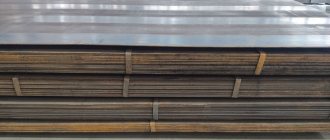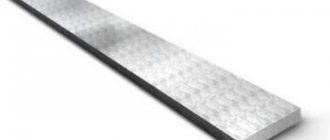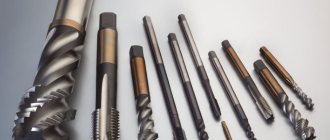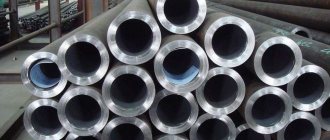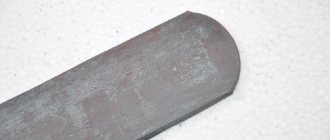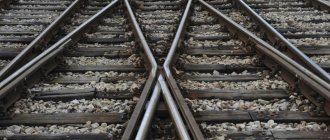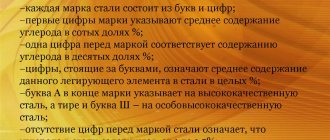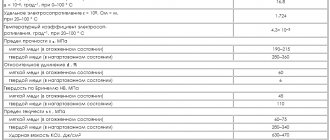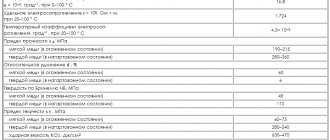Decoding
In accordance with GOST 380-2005, the full name of the steel is 3 st3Gsp. The brand indicates the chemical composition, serial number and degree of deoxidation.
- St means that this is a grade of steel of ordinary quality. The quality of steel is determined by the level of sulfur and phosphorus content; the lower the concentration, the higher the quality. There are ordinary, high-quality, high-quality and especially high-quality steels. The content of sulfur and phosphorus in ordinary alloys does not exceed 0.06% and 0.07%.
- Number 3 is the conditional number of the brand according to GOST. GOST 380-2005 regulates carbon steels of ordinary quality; the grade number is assigned to the alloy according to its chemical composition.
- The letter G indicates the manganese content.
- Cn degree of deoxidation of steel. Deoxidation of steel is the process of removing oxygen from it, preventing oxidation and “boiling” and the release of gas during solidification. There are calm (sp), semi-quiet (ps) and boiling (kp) steels. Strongly deoxidized steels are called calm, and weakly boiling steels. The weaker the deoxidation, the higher the porosity of the steel. St3Gsp steel is considered to be calm; it has a semi-quiet version - st3ps steel.
Production nuances
The characteristics of a metal are determined based on its chemical composition and manufacturing technology. The basis of ST3PS steel is ferrite - a solid solution of carbon, nickel and chromium. The more carbon a material contains, the higher its strength.
Undesirable impurities in the composition are sulfur (0.05%) and phosphorus (0.04%). Sulfur forms sulfur grains, which causes red brittleness in steel. Phosphorus interacts with ferrite, which reduces ductility when working at elevated temperatures and increases cold brittleness in the cold.
For the production of ST3PS steel, open-hearth and converter production methods are used. The basic characteristics of the metal are identical for any method, but the converter method has a lower cost.
Return to content
Chemical composition
98% of the composition of St3 steel is iron. The carbon content in the composition of st3 is low. It is enough to provide hardness to the alloy, while at the same time it does not reduce the toughness of the steel and its ductility. You can also find in the composition:
- Silicon. This element is the main deoxidizer of the alloy. Thanks to it, St3 steel acquires a fine-grained structure, and it also increases strength without reducing ductility.
- Manganese. A deoxidizer that promotes the removal of sulfur. Thanks to manganese, steel improves its surface quality, steel is better welded, forged, and becomes resistant to wear.
- Sulfur. A harmful impurity that causes an increase in red brittleness and the risk of cracking during high-temperature processing.
- Phosphorus. A harmful impurity that greatly reduces the temperature range of use of steels. Due to phosphorus, steel loses its ductility at high temperatures, and at low temperatures it becomes prone to brittleness.
- Nickel, copper, chromium, nitrogen, aluminum. Elements may be present in the composition of steel 3, but do not affect its characteristics due to their insignificant concentration.
Phosphorus and sulfur have a negative impact on weldability and cause welds to become porous and prone to cracking.
Chemical composition in % of the material St3sp
GOST 380-2005
| C | Si | Mn | Ni | S | P | Cr | N | Cu | As |
| 0.14 — 0.22 | 0.15 — 0.3 | 0.4 — 0.65 | up to 0.3 | up to 0.05 | up to 0.04 | up to 0.3 | up to 0.008 | up to 0.3 | up to 0.08 |
Chemical composition, % (GOST 380-2005)
| steel grade | Mass fraction of chemical elements | ||
| carbon | manganese | silicon | |
| St3sp | 0,14-0,22 | 0,40-0,65 | 0,15-0,30 |
Varieties
Classification is carried out according to the degree of deoxidation. Deoxidation is a process by which foreign impurities in the form of carbon are removed from the alloy. Its presence reduces the beneficial properties of the material.
Depending on the degree of deoxidation, the following types of alloys are distinguished:
- “sp” - calm;
- “ps” - semi-calm;
- "kp" - boiling.
The abbreviation St3 denotes steel with a carbon percentage of three. Depending on its quantity in the alloy, this figure increases or decreases.
Purpose
Steel 3 and other alloys of this class are superior in scope to all other types of steel. It is used for the production of forged products, fences, gates, and decorative elements. In construction as a material for load-bearing, non-load-bearing, welded and non-welded building structures. Pipes and fittings, parts of mechanisms for operation at positive temperatures are made from it. St3 steel is used in the chemical, oil and gas industries, as well as in mechanical engineering.
Due to its simple chemical composition, availability, performance characteristics, and physical properties, steel 3 is one of the most common materials in industries that require a lot of steel. For example, in the construction of railways and pipelines for transporting natural gas or water.
Where and how is it used?
The performance qualities allow the alloy to be used for the manufacture of elements of welded structures operating under load, machine parts and mechanisms. The operating temperature must be above 0 degrees. The fifth category of rolled elements can be used in conditions of negative temperatures -40/-425 C under the action of a variable load.
Complex products require subsequent heat treatment; annealing is most often used. It reduces residual stresses after welding. The scope of application of ST3PS includes the production of At-400S fittings.
The sheets are used to produce parts using cold stamping. The result is pallets for collecting cutting fluids in production, containers of various volumes and purposes, casings, etc.
Return to content
Advantages and disadvantages
The main distinguishing feature of St3 steel is its combination of positive characteristics or versatility. This means that it does not have any one key advantage, it shows decent characteristics from all sides, which makes it the first on the market. This steel is not intended for highly specialized applications in special conditions, but is ideal for a wide range of everyday applications.
The disadvantages of steel include low performance at low temperatures.
Advantages of steel st3Gsp:
- homogeneous structure, due to which the steel becomes homogeneous, ductile and protected from adverse environmental influences;
- resistance to atmospheric corrosion;
- high elasticity and hardness;
- insensitivity to flakes;
- impact strength, allowing to withstand dynamic loads well;
- not subject to temper brittleness;
- simple production process, no expensive alloying additives;
- relatively low cost.
Separately, it should be mentioned that the material is perfectly weldable. It can be carried out using any known technology without preliminary and subsequent treatments.
Characteristics
St3 is characterized as carbon structural steel of ordinary quality. Steel does not contain alloying additives that protect it from external influences. For use in aggressive chemical environments or conditions of high humidity, it is necessary to coat the steel with a protective layer. St3 has good weldability, high strength, and resists loads well, which allows it to be used in load-bearing structures. The price of St3 steel is optimal for the construction of facilities or laying communications that require a large amount of metal. Density St3 - 7850 kg/m3.
Explanation and general description
This type of metal is carbon structural steel of ordinary quality. Complies with GOST 380-2005.
This marking is deciphered as follows:
- “St” is the actual name of the metal.
- “3” – brand number, determined by the chemical composition of the material.
- “sp” – calm. These letters indicate the degree of deoxidation of the steel, and “say” that when the substance hardens, almost no gas is released.
Steel with this marking is characterized by the most homogeneous composition, which makes it less brittle and gives it increased resistance to the aggressive effects of various factors. At the same time, the material remains plastic and can be processed quite easily.
Such steel is produced using the oxygen-converter or open-hearth method. In the first case, the metal is produced by exposing cast iron to oxygen. Oxygen supplied under high pressure burns carbon out of cast iron and allows the metal to acquire new characteristics.
In the second case, the steel is melted in special open-hearth furnaces under high temperatures. At the same time, regardless of the production method, the characteristics of the metal do not change.
Assortment
- Channels are parallel (P), with sloped flanges (U), equal-flange bent;
- round sections circle and reinforcement;
- VGP pipes, electric welded (ES), seamless (BGD);
- I-beams, wide-flange, column, special, with flange slopes;
- steel square;
- corners equal and unequal;
- square and rectangular profile;
- sheet steel: hot-rolled, corrugated, expanded metal, strip.
Types of delivery
- Hot rolled sheets, including strip and tape;
- forgings;
- rails;
- pipes;
- rod and wire.
Application
The following are made from St3sp metal:
- shaped metal products, which include a channel, an I-beam and other types of products;
- varietal;
- rolled sheets of various thicknesses.
In addition, the material is widely used in the production of pipes for various purposes and sections, steel strips, hardware and stampings.
Products made from this type of steel are used in a wide variety of areas: from the construction and laying of above-ground and underground communications to the manufacture of industrial machines and units operated even in difficult conditions.
The technical characteristics of the material allow it to be used in the construction of frames and supporting structures, which are subject to increased requirements.
Substitutes
A substitute is an alloy that is closest in performance characteristics to the main one. Substitutes for St3 are usually one of three domestic brands: S245, S285, VSt3Sp.
It is acceptable to use foreign analogues that differ in markings, but are available in any corner of the world map. They are:
IN THE USA:
- A57036;
In Great Britain:
- 40B;
- 722M24;
In Germany:
- 0038;
In France:
- E24-2;
- E24-4.
In Japan:
- SS330;
- In Italy:
- Fe360B;
In China:
In Austria:
In Hungary
Comparison with alloy structural steels
Steel st3 is a carbon structural steel of ordinary quality. It is used to produce welded and non-welded structures, heavily loaded trusses and other load-bearing elements. St3 is resistant to atmospheric corrosion, but without a protective coating it will deteriorate upon prolonged contact with moisture or an aggressive chemical environment.
Alloy structural steel is protected from corrosion by alloying elements, so it can be used without a protective layer when in contact with moisture and aggressive environments. Alloy steel is more difficult to produce, more expensive and more prone to brittleness. The processing of such steel may require special conditions, while the more affordable and easier to produce steel 3 does not require any special processing conditions.
Comparison with alloy tool steels
Alloy tool steel is used in the production of tools. Alloying additives are aimed at improving the quality of steel, thanks to them it is possible to achieve a significant advantage over carbon alloys. These include:
- red fastness;
- high hardenability;
- resistance to impact loads (especially important for impact tools);
- wear resistance.
St3 steel is structural and, as a rule, is not used for the manufacture of moving parts of tools.
Foreign analogues
| Europe EN 10027-1 (EN 10027-2) | S235JR (1.0038) |
| Germany DIN | RSt37-2, USt37-2 |
| USA (AISI, ASTM) | A238/C |
| France (AFNOR) | E 24-2 |
| UK BS | 40B |
| Czech Republic (CSN) | 11375 |
| Poland PN/H | St3SV, St3SJ, St3S4U |
Technological properties
Technological properties of the material St3sp.
| Weldability: | no limits. |
| Flock Sensitivity: | not sensitive. |
| Tendency to temper brittleness: | not inclined. |
Temperature of critical points, °C
| Ac1 | Ac3 | Ar3 | Ar1 |
| 735 | 850 | 835 | 680 |
Standardized indicators of St3sp steel by rolled category (GOST 535-2005)
| Category | Chemical composition | Temporary resistance σв | Yield strength σt | Relative elongation δ5 | Cold bending | Impact strength | ||||
| KCU | KCV | |||||||||
| At temperature, °C | After mechanical aging | At temperature, °C | ||||||||
| + 20 | -20 | + 20 | -20 | |||||||
| 1 | — | + | + | + | + | — | — | — | — | — |
| 2 | + | + | + | + | + | — | — | — | — | — |
| 3 | + | + | + | + | + | + | — | — | — | — |
| 4 | + | + | + | + | + | — | + | — | — | — |
| 5 | + | + | + | + | + | — | + | + | — | — |
| 6 | + | + | + | + | + | — | — | — | + | — |
| 7 | + | + | + | + | + | — | — | — | — | + |
Parameters for the use of electric-welded straight-seam pipes made of St3sp steel (GOST 32569-2013)
| Steel grade, strength class, standard or specifications | StZsp5 GOST 380 | StZsp4-5 GOST 380 | StZsp4 GOST 380 | ||||
| Technical requirements for pipes (standard or specifications) | GOST 10705 group B | GOST 10706 group B | TU 14-3-377-87 | TU 14-3-1399-95 | GOST 10706 group B | ||
| Nominal diameter, mm | 10-500 | 450-1400 | 200-400 | 200, 350, 400, 500 | 400-1400 | ||
| Types of tests and requirements (standard or specifications) | GOST 10705 | GOST 10706 | TU 14-3-377-87 | TU 14-3-1399-95 | GOST 10706 | ||
| Transported medium (see designations in table 5.1) | Group B, C environments | Group B media Group B media, except LPG | Group B media, except steam and hot water | All media except group A(a) and LPG | Group B media, except LPG | ||
| Pipeline design parameters | Maximum pressure, MPa | ≤1,6 | ≤2,5 | ≤1,6 | |||
| Maximum temperature, °C | 300 | 200 | 300 | 200 | |||
| Pipe wall thickness, mm | — | ≤12 | — | ≤10 | — | ||
| Minimum temperature depending on the pipe wall thickness with stress in the wall from internal pressure [σ], °C | more than 0.35[σ] | minus 20 | |||||
| no more than 0.35[σ] | minus 40 | ||||||
Parameters for the use of electric-welded spiral-welded pipes made of St3sp steel (GOST 32569-2013)
| Steel grade, strength class, standard or specifications | StZspZ, StZsp2 GOST 380 | StZsp5 GOST 380 | ||
| Technical requirements for pipes (standard or specifications) | TU 14-3-943-80 | TU 14-3-954-80 | ||
| Nominal diameter, mm | 200-500 | 500-1400 | ||
| Types of tests and requirements (standard or specifications) | TU 14-3-943-80 | TU 14-3-954-80 taking into account the requirements of clause 2.2.10 GOST 32569-2013 | ||
| Transported medium (see designations in table 5.1) | All media except group A and LPG | All media except group A and LPG | ||
| Pipeline design parameters | Maximum pressure, MPa | ≤1,6 | ≤2,5 | |
| Maximum temperature, °C | 200 | 300 | ||
| Pipe wall thickness, mm | ≤6 | ≤12 | ||
| Minimum temperature depending on the pipe wall thickness with stress in the wall from internal pressure [σ], °C | more than 0.35[σ] | minus 30 | minus 20 | |
| no more than 0.35[σ] | — | minus 20 | ||
Application of St3sp steel for fasteners (GOST 32569-2013)
| steel grade | Technical requirements | Acceptable operating parameters | Purpose | |
| Wall temperature, °C | Medium pressure, MPa (kgf/cm2), no more | |||
| StZsp4 GOST 380 | STP 26.260.2043 | -20 to +300 | 2,5 (25) | Studs, bolts, nuts |
| 10 (100) | Washers | |||
Conditions for using St3sp steel for bodies, covers, flanges, membranes and valve assembly made from rolled products, forgings (stampings) (GOST 33260-2015)
| Material | ND for supply | Temperature of the working medium (wall), °C | Additional instructions for use |
| St3sp GOST 380 | Forgings GOST 8479 Long products GOST 535, categories 3-5 | -30 to 300 | For welded fittings for pressure PN≤2.5 MPa (25 kgf/cm2) |
| Sheet GOST 14637, categories 3-6 | -20 to 300 | For welded fittings for pressure PN 5 MPa (50 kgf/cm2). For categories 4, 5, sheet thickness for St3sp is no more than 25 mm; for category 3 sheet thickness no more than 40 mm |
Resistance of structural materials against crevice erosion (GOST 33260-2015)
| Durability group | Point | Erosion resistance against steel 12X18H10T | Material |
| Unstable | 6 | 0,005-0,05 | Steel VSt3sp3 and its welded joints. |
NOTE. The coefficient of erosion resistance of a material is the ratio of the rate of erosive wear of the material to the rate of erosive wear of steel 12Х18Н10Т (taken as 1).
Mechanical properties of rolled products under tension, as well as cold bending test conditions (GOST 535-2005)
| steel grade | St3sp | |
| Tensile strength σв, N/mm2 (kgf/mm2), for rolled thicknesses, mm | up to 10 incl. | 380-490 (39-50) |
| St.10 | 370-480 (38-49) | |
| Yield strength σт, N/mm2 (kgf/mm2), for rolled thickness, mm (not less) | up to 10 incl. | 255(26) |
| St. 10 to 20 incl. | 245(25) | |
| St. 20 to 40 incl. | 235(24) | |
| over 40 to 100 incl. | 225(23) | |
| St. 100 | 205(21) | |
| Relative elongation δ5, %, for rolled thicknesses, mm (not less) | up to 20 incl. | 26 |
| over 20 to 40 incl. | 25 | |
| St.40 | 23 | |
| Bending until the sides are parallel (a - sample thickness, d - mandrel diameter), for rolling thicknesses, mm | up to 20 incl. | d = a |
| St.20 | d = 2a | |
NOTE
- By agreement between the manufacturer and the consumer, the following is allowed:
- reduction in yield strength by 10 N/mm2 (1 kgf/mm2) for shaped steel with a thickness of over 20 mm;
- reduction in relative elongation by 1% (abs.) for shaped rolled products of all thicknesses.
- It is allowed to exceed the upper limit of tensile strength by 49.0 N/mm2 (5 kgf/mm2), and by agreement with the consumer - without limiting the upper limit of tensile strength, provided that other standards are met. At the request of the consumer, exceeding the upper limit of temporary resistance is not allowed.
Impact strength of rolled products (GOST 535-2005)
| steel grade | St3sp | ||
| Rolled thickness, mm | St. 5.0 to 10.0 incl. | ||
| KCU, J/cm2 (kgf*m/cm2), not less | Sample type according to GOST 9454 | 2,3 | |
| At temperature, °C | +20 | 108(11) | |
| -20 | 49(5) | ||
| After mechanical aging | 49(5) | ||
| KCV, J/cm2 (kgf*m/cm2), not less | Sample type according to GOST 9454 | 12,13 | |
| At temperature, °C | +20 | 34(3,5) | |
| -20 | — | ||
NOTE
- The “-” sign means that the indicator is not standardized.
- Determination of the impact strength of round rolled products is carried out starting from a diameter of 12 mm, square - starting from the square side of 11 mm.
- It is allowed to reduce the value of impact strength on one sample by 30%, while the average value must not be lower than the standards specified in this table.
- Impact strength KCV is determined for rolled products with a thickness of up to 20 mm inclusive.
Mechanical restoration
Parts made from steel grade ST3PS are processed using pre-selected equipment and speed. This ensures that the required performance indicators are maintained, reduces local stresses, etc.
Sharpening and milling is carried out using a cutting tool made of VK8 or T5K10. Internal and external threads are created using taps and dies made of R18 and R6M5 steel. When processing on a machine, it is necessary to use cutting fluids, and when processing manually, castor oil.
The impact strength of ST3PS steel allows products to be processed on machine tools under constant vibration load. The speed depends on the properties of the alloy; other parameters are also selected:
- thickness 6-10 cm – tool holder 16*25 mm;
- cutting depth 3 mm – feed speed 0.7-1.2 mm/rev;
- rotation speed 700 rpm.
Return to content
Mechanical properties
Mechanical properties of rolled products
| GOST | Delivery status | Section, mm | σ0.2, MPa | σв, MPa | δ5(δ4),% |
| no less | |||||
| GOST 380-94 | Hot rolled products | Up to 20 | 245 | 370-480 | 26 |
| St. 20 to 40 | 235 | 25 | |||
| St. 40 to 100 | 225 | 23 | |||
| St. 100 | 205 | 23 | |||
| GOST 16523-89 (transverse samples) | Hot rolled sheet | Up to 2.0 incl. | — | 370-480 | (20) |
| St. 2.0 to 3.9 incl. | (22) | ||||
| Cold rolled sheet | Up to 2.0 incl. | — | 370-480 | (22) | |
| St. 2.0 to 3.9 incl. | (24) | ||||
Mechanical properties of forgings
| GOST | Heat treatment | Section, mm | σ0.2, MPa | σв, MPa | δ5,% | ψ, % | KCU, J/cm2 | Hardness HB |
| no less | ||||||||
| GOST 8479-70 | Normalization | Up to 100 | 175 | 353 | 28 | 55 | 64 | 101-143 |
| 100-300 | 175 | 353 | 24 | 50 | 59 | |||
| Up to 100 | 195 | 392 | 26 | 55 | 59 | 111-156 | ||
| 100-300 | 195 | 392 | 23 | 50 | 54 | |||
Impact strength KCU (GOST 380-94)
| Type of rental | Pattern cutting direction | Section, mm | KCU, J/cm2 | ||
| +20 °C | -20 °C | after mechanical aging | |||
| no less | |||||
| Sheet | Transverse | 5-9 | 78 | 39 | 39 |
| 10-25 | 68 | 29 | 29 | ||
| 26-40 | 49 | — | — | ||
| Wide band | Longitudinal | 5-9 | 98 | 49 | 49 |
| 10-25 | 78 | 29 | 29 | ||
| 26-40 | 68 | — | — | ||
| Varietal and shaped | Same | 5-9 | 108 | 49 | 49 |
| 10-25 | 98 | 29 | 29 | ||
| 26-40 | 88 | — | — | ||
Mechanical properties at elevated temperatures
| tsp, °C | σ0.2, MPa | σв, MPa | δ5,% | ψ, % | KCU, J/cm2 |
| Hot rolled billet dimensions 140×120 mm | |||||
| 20 | 220 | 445 | 33 | 59 | 154 |
| 300 | 205 | — | — | — | 199 |
| 500 | 180 | 285 | 34 | 80 | 119 |
| Hot-rolled sheets and shapes up to 30 mm thick | |||||
| 20 | 205-340 | 420-520 | 28-37 | 56-68 | — |
| 200 | 215-285 | — | — | — | — |
| 300 | 05-265 | — | — | — | — |
| 400 | 155-255 | 275-490 | 34-43 | 60-73 | — |
| 500 | 125-175 | 215-390 | 36-43 | 60-73 | — |
| A sample with a diameter of 6 mm and a length of 30 mm is forged and normalized. Deformation speed 16 mm/min, strain rate 0.009 1/s | |||||
| 700 | 73 | 100 | 57 | 96 | — |
| 800 | 51 | 63 | 95 | 95 | — |
| 900 | 38 | 65 | 84 | 100 | — |
| 1000 | 25 | 43 | 79 | 100 | — |
| 1100 | 19 | 31 | 80 | 100 | — |
| 1200 | 14 | 25 | 84 | 100 | — |
Endurance limit
| Sample | σ-1, MPa | n |
| Smooth | 191 | 107 |
| Notched | 93 | 107 |
